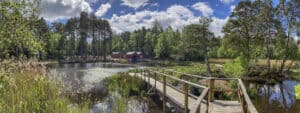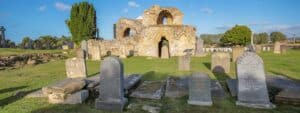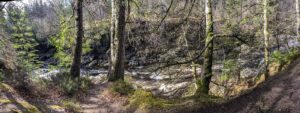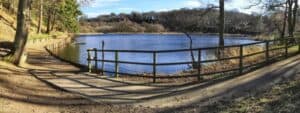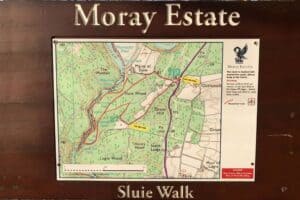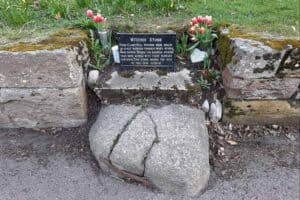Tallest carved stone in Scotland
This outstanding monolith is the tallest carved standing stone in Scotland and one of the most richly-carved examples in the UK.
This enormous carved stone is thought to have been put here by the Picts, and likely show scenes of a battle between them and Norse invaders.
It was discovered buried in the ground in the 18th century, and given the name ‘Sueno’s Stone’
At six metres (20 feet), it is now encased in a glass structure to protect it from the elements. It stands at the east end of the town, and is easily accessed from the main road through the town centre just before it joins the A96. Follow the old Findhorn Road which leads to a quiet residential area.
Intricate carvings completely cover both sides and edges of the stone.
One side has a huge ring-headed cross, and this is decorated with carvings of knotwork, the other side is like a tapestry, split into four panels showing the progress of a battle from top to bottom.
It shows cavalry, foot soldiers, and the beheading of the enemy. Experts have dated the carvings to around the 9th/10th centuries.
There are at least three theories as to which conflict this carving depicts, and details of all are on panels at the site. A visit is a must, not just to learn more, but to be awed by the sheer size of this gigantic storytelling stone.
Cycle path to Findhorn
It is here where the cycle path leaves Forres. A wide path for cyclists and pedestrians leads to Findhorn and onto the Moray Coast Trail. It passes through Kinloss.





Historical timeline
- 9th–10th Century AD: Sueno’s Stone was carved during this period, featuring intricate designs that include a large cross on the west face and detailed battle scenes on the east face. The exact purpose and the patrons who commissioned the stone remain subjects of scholarly debate.
- Circa 1590: Timothy Pont’s “Mapp of Murray” depicts two standing stones near Forres, suggesting that Sueno’s Stone may have had a companion monument, though no trace of a second stone exists today.
- Early 18th Century: Lady Ann Campbell, Countess of Moray, took measures to stabilize Sueno’s Stone by constructing stepped plinths around its base, which are still visible today.
- 1726: Historian Alexander Gordon documented the stone in his work “Itinerarium Septentrionale,” referring to it as “Sueno’s Stone,” possibly linking it to Sweyn Forkbeard, though this association lacks concrete evidence.
- 1747: James Ray, a participant in the Jacobite rising, mentioned observing the stone as the government army marched past Forres, indicating its prominence in the landscape at that time.
- 1990–1991: Archaeological excavations around Sueno’s Stone were conducted, revealing insights into its foundation and suggesting it may have been one of two monumental stones.
- Early 1990s: To protect the stone from environmental degradation and vandalism, it was enclosed within a glass canopy, ensuring its preservation for future generations.
Further information
We currently have no external resources about this attraction.Facilities
Travel itinerary planner
Sueno’s Stone is in the following sections: Rather than give you a fixed itinerary, here you’ll find details of nearby attractions and links (tags) to help you find activities similar to those at this location. Don’t rush, slow down, go at your own pace and enjoy your experiences fully. You can use this information to help you plan your stay without missing a thing.- Distance from Forres: 0.8 miles
- Postcode: IV36 3WX
- What3words: applauded.strain.reserved
- What’s nearby: Forres
- Tags: architecture, history (all areas)



